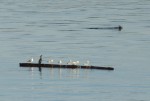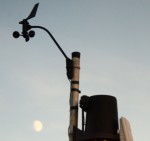Sunny
Wind 18 knots from the North in the morning, switching direction to SE and diminishing throughout the day to calm in the evening
Air temperature: high 10C, low 5C
Ocean temperature 8.8C
There is never a dull moment at Race Rocks. At 8:30 in the morning, Chunk (the large male elephant seal) and the female elephant seal that has been on the island for a couple weeks were on the grass to the north of the Ecoguardian’s House. From the window by the front porch, I watched as the female roared and kicked up grass with her flippers as she and Chunk were either fighting or mating. It’s hard to tell the difference. He approached her and bit into her back, adding to the many wounds and scars. The female fled to the other side of the house and Chunk followed. They spent the rest of the day at least 10 metres apart from each other on the west side of the house.
At 10:30, I was sitting in the house reading the SOP manual when I heard and felt a huge blast. There was a large puff of smoke rising from the Canadian Forces Ammunition Base Rocky Point, 2km to the NW. There were red flags to warn passing boaters. After the initial blast, a group of people appeared from a bunker to inspect the area where the munitions were detonated. There were a few more blasts in the next two hours.
There are lots of flowers springing up around the island: daffodil, crocus, grape hyacinth, and calendula. Like several other plants that are not native to the island, they were planted by lighthouse keepers.
I spent the day reacquainting myself with the systems and species of the island.
The fog horn went off sporadically throughout the night, starting at 20:15. There didn’t appear to be any fog or clouds. The almost full moon lit up the night. It was so bright, I didn’t need to use a flashlight when I went to turn off the generator.
-

-
Chunk attacks or mates with the female elephant seal just below the north porch of the Ecoguardian’s House.
-

-
The red flag at Rocky Point signals that blasting is happening. The DND personnel appeared from a bunker just after a large blast that shook the house, which is about two kilometres away.
-

-
A bald eagle perches on top of camera 5.
-

-
Chunk spent most of the day on the grass to the west of the Ecoguardian’s House.
-

-
The female elephant seal laying on the grass, occasionally roaring at Chunk when he got too close to her. There are some new wounds on her back from Chunk attacking her earlier in the morning.
-

-
One of the many bunches of daffodils that have sprung up around the island. Chunk’s silhouette in the background.
-

-
Crocuses that were partially squashed by an elephant seal.
-

-
A large fire burned for the whole day at the Canadian Forces Ammunition Base Rocky Point. They were burning gorse, an invasive species.













































